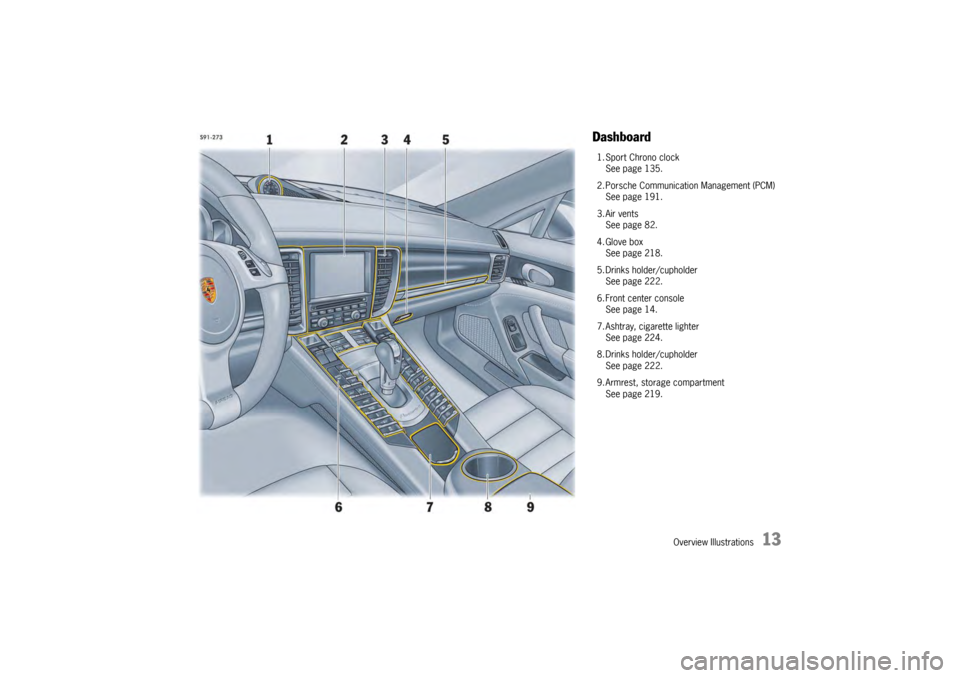2009 PORSCHE PANAMERA page 42
[x] Cancel search: page 42Page 2 of 343

Porsche, the Porsche Crest, Panamera, PCCB,
PCM, PDK, PSM and Tequipment are registered
trademarks and the distinctive shapes of Porsche
automobiles are trademarks of Dr. Ing. h.c. F.
Porsche AG.
All rights reserved.
Printed in Germany
Orientation guides in the Owner’s ManualThe orientation guides in the Owner’s Manual are
highlighted in yellow.
Overall Table of Contents
At the start of the Owner’s Manual you will find an
overview of the overall contents of the Owner’s
Manual.
Section Contents
There is a summary of topics with the
corresponding page numbers at the beginning of
each main chapter.
Index
There is a detailed, alphabetical index at the end
of this Owner’s Manual.
WKD 970 121
10 06/09
Page 5 of 343

3
California Proposition 65 Warning
Warning!
Engine exhaust, some of its constituents, and
certain vehicle components contain or emit chemi-
cals known to the State of California to cause
cancer and birth defects or other reproductive
harm.
In addition, certain fluids contained in vehicles and
certain products of component wear contain or
emit chemicals known to the State of California to
cause cancer and birth defects or other reproduc-
tive harm.Hot Exhaust Pipes
Warning!
Risk of burn injury when standing near or
coming into contact wi th the exhaust pipe.
The exhaust pipe is hot when the vehicle is running
and remains hot for some time after the vehicle is
turned off.
f To prevent injury, make a point of noting where
your vehicle’s exhaust pipe is, avoid placing
your legs near the exhaust pipe when loading
and unloading cargo in the rear, and closely
supervise children around the vehicle during
time when the exhaust pipe could be hot.A hot exhaust pipe can cause serious burns.
Portable Fuel Containers
Danger!
Portable fuel containers may leak, whether
they are full or partially empty. Fuel leaking
from a portable container carried in your
vehicle could, in case of an accident, cause
a fire or explosion, resulting in serious
personal injury or death.
f Never carry additional fuel in portable contai-ners in your vehicle.
Ground Clearance
Caution!
Risk of damage. The vehicle may touch the
ground as a result of reduced ground clear-
ance.
f Drive carefully and slowly on steep slopes
(e. g. parking lots, curbs, uneven roads, lifting
platforms etc.).
fAvoid steep ramps.
Porsche Ceramic Composite Brake
(PCCB)f Please see the chapter “BRAKES” on
Page 172.
The high-performance brake system is designed
for optimal braking effect at all speeds and
temperatures.
Certain speeds, braking forces and ambient condi-
tions (such as temperature and humidity) therefore
might cause brake noises.
Wear on the different components and braking
system, such as brake pads and brake discs,
depends to a great extent on the individual driving
style and the conditions of use and therefore
cannot be expressed in actual miles on the road.
The values communicated by Porsche are based
on normal operation adapted to traffic. Wear
increases considerably when the vehicle is driven
on race tracks or through an aggressive driving
style.
f Please consult an authorized Porsche dealer
about the current guidelines in effect before
such use of your vehicle.
Page 6 of 343

4Dear Porsche Owner,A lot has gone into the manufacture of your
Porsche, including advanced engineering, rigid
quality control and demanding inspections. These
engineering and safety features will be enhanced
by you…the safe driver…– who knows her/his car and all controls,
– who maintains the vehicle properly,
– who uses driving skills wisely and always drives within her/his own capabilities and the
level of familiarity with the vehicle.
You will find helpful hints in this manual on how to
perform most of the checks listed on the following
pages. If in doubt, have these checks performed
by your authorized Porsche dealer.
Before driving off…Check the following items firstf Turn the engine off before you attempt any
checks or repairs on the vehicle.
f Be sure the tires are inflated correctly.
Check tires for damage and tire wear.
f See that wheel bolts are properly tightened
and not loose or missing.
f Check engine oil level, add if necessary. Make
it a habit to have engine oil checked with every
refueling.
f Check all fluid levels such as windshield
washer and brake fluid levels.
f Be sure the vehicle battery is well charged and
cranks the engine properly.
f Check all doors and lids for proper operation
and latch them properly.
f Check and if necessary replace worn or
cracked wiper blades.
f See that all windows are clear and unobst-
ructed.
f Check air intake slots and area between
engine compartment lid and windshield.
Ensure that these areas are free of snow and
ice, so the heater and the windshield wipers
work properly. f
If a child will be riding in the vehicle, check
child seat/child seat restraint system to ensure
that restraints are properly adjusted.
f Check all exterior and interior lights for opera-
tion and that the lenses are clean.
f Check the headlights for proper aim, and if
necessary, have them adjusted.
f Check under the vehicle for leaks.
f Be sure all luggage is stowed securely.
Emergency equipmentIt is good practice to carry emergency equipment
in your vehicle.
Some of the items you should have are: window
scraper, snow brush, container or bag of sand or
salt, emergency light, small shovel, first-aid kit,
etc.
Page 7 of 343

5
In the driver’s seat…fCheck operation of the horn.
f Position seat for easy reach of foot pedals and
controls.To reduce the po ssibility of injury from
the air bag deployment, you should always sit
back as far from the steering wheel as is
practical, while still maintaining full vehicle
control.
f Adjust the inside and outside rear view mirrors.
f Buckle your safety belts.
f Check operation of the foot and electric
parking brake.
f Check all warning and indicator lights with
ignition on and engine not running.
f Start engine and check all warning displays for
warning symbols.
f Never leave an idling car unattended.
f Lock doors from inside, especially with
children in the car to prevent inadvertent
opening of doors from inside or outside. Drive
with doors locked.
On the road…fNever drive after you have consumed alcohol
or drugs.
f Always have your safety belt fastened.
f Always drive defensively.
Expect the unexpected.
f Use signals to indicate turns and lane changes.
f Turn on headlights at dusk or when the driving
conditions warrant it.
f Always keep a safe distance from the vehicle in
front of you, depending on traffic, road and
weather conditions.
f Reduce speed at night and during inclement
weather.
Driving in wet weather requires caution and
reduced speeds, particularly on roads with
standing water, as the handling characteristics
of the vehicle may be impaired due to hydro-
planing of the tires.
f Always observe speed limits and obey road
signs and traffic laws.
f When tired, get well off the road, stop and take
a rest. Turn the engine off. Do not sit in the
vehicle with engine idling.
Please see the chapter “ENGINE EXHAUST” on
Page 2. f
When parked, always put the electric parking
brake on and put the PDK selector lever in
position P.
On hills also turn the front wheels toward the
curb.
f When emergency repairs become necessary,
move the vehicle well off the road. Turn on the
emergency flasher and use other warning
devices to alert other motorists. Do not park
or operate the vehicle in areas where the hot
exhaust system may come in contact with dry
grass, brush, spilled fuel or other flammable
material.
f Make it a habit to have the engine oil checked
with every refueling.
Page 8 of 343

6Break in hints for the first
2,000 miles (3,000 kilometers)The following tips will be helpful in obtaining
optimum performance from your new Porsche.
Despite the most modern, high-precision manufac-
turing methods, the moving parts must still wear
in with each other. This we aring-in occurs mainly in
the first 2,000 miles (3,000 km).Therefore:f Preferably take longer trips.
f Avoid frequent cold starts with short-distance
driving whenever possible.
f Avoid full throttle starts and abrupt stops.
f Do not exceed maximum engine speed of
4,200 rpm (revolutions per minute).
f Do not run a cold engine at high rpm either in
Neutral or in gear.
f Do not let the engine labor, especially when
driving uphill. Shift to the next lower gear in
time (use the most favorable rpm range).
f Never lug the engine in high gear at low
speeds. This rule applies at all times, not just
during the break-in period. f
Do not participate in motor racing events,
sports driving schools, etc. during the first
2,000 miles (3,000 kilometers).
There may be a slight stiffness in the steering or
other controls during the br eak-in period which will
gradually disappear.
Break in brake pads and brake discsNew brake pads and discs ha ve to be ”broken in“,
and therefore only attain optimal friction when the
car has covered several hundred miles or km.
The slightly reduced braking ability must be
compensated for by pressing the brake pedal
harder. This also applies whenever the brake pads
and brake discs are replaced.New tiresNew tires do not have maximum traction. They
tend to be slippery.
f Break in new tires by driving at moderate
speeds during the first 60 to 120 miles (100
to 200 km). Longer braking distances must be
anticipated.
Engine oil and fuel consumptionDuring the break-in peri od oil and fuel consump-
tion may be higher than normal.
f Please see the chapter “ENGINE DATA” on
Page 324.
As always, the rate of oil consumption depends on
the quality and viscosity of oil, the speed at which
the engine is operated, the climate and road
conditions, as well as the amount of dilution and
oxidation of the lubricant.
f Make a habit of checking engine oil with every
refueling, add if necessary.
Page 13 of 343

Overview Illustrations
11
Driver’s Cockpit1. Door openerSee page 32.
2. Vehicle setting memory buttons See page 40.
3. Electric parking brake See page 171.
4. Steering wheel adjustment See page 62.
5. Overhead operating console See page 15.
6. Power windows See page 86.
7. Exterior-mirror setting See page 58.
8. Engine compartment lid release See page 33.
9. Diagnostic socket (OBD)
10.Light switch See page 92.
11.Ignition lock, steering lock See page 164.
12.Dimming of instrument lighting See page 95.
13.Seat adjustment See page 39.
Page 14 of 343

12
Overview Illustrations
Steering Wheel and Instrument
Panel1. Turn signal lightsSee page 96.
2. Engine oil pressure gauge See page 111.
3. Engine oil temperature gauge See page 110.
4. Speedometer See page 110.
5. Tachometer See page 110.
6. Multi-function display See page 115.
7. Windshield wipers See page 102.
8. Coolant temperature gauge See page 110.
9. Fuel gauge See page 111.
10.PDK shift buttons See page 61.
11.Adaptive cruise control See page 178.
12.Horn See page 61.
13.Telephone controls, multi-function display See page 115.
Page 15 of 343

Overview Illustrations
13
Dashboard1. Sport Chrono clockSee page 135.
2. Porsche Communication Management (PCM) See page 191.
3. Air vents See page 82.
4. Glove box See page 218.
5. Drinks holder/cupholder See page 222.
6. Front center console See page 14.
7. Ashtray, cigarette lighter See page 224.
8. Drinks holder/cupholder See page 222.
9. Armrest, storage compartment See page 219.